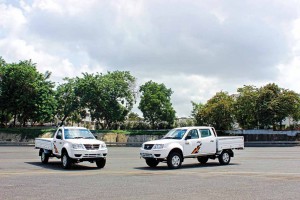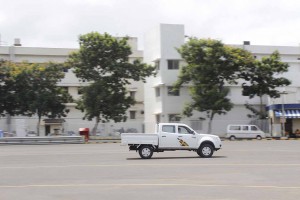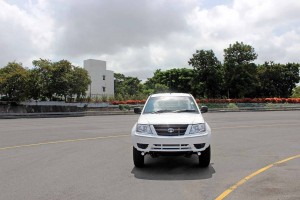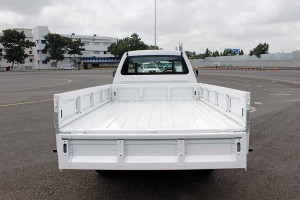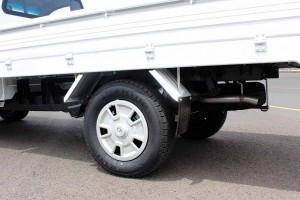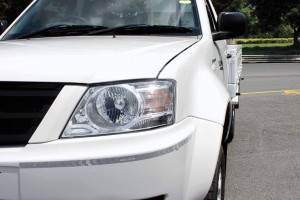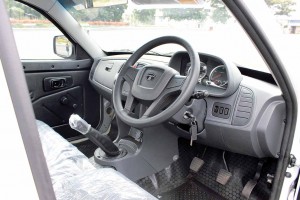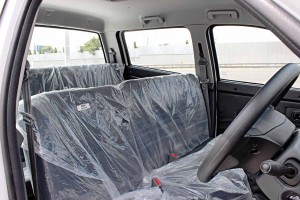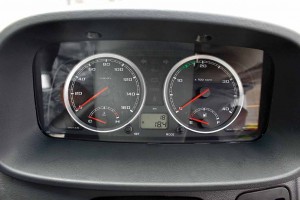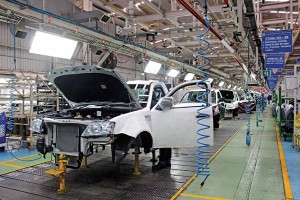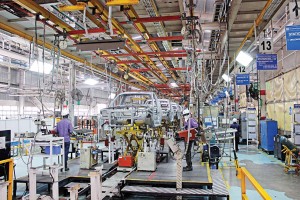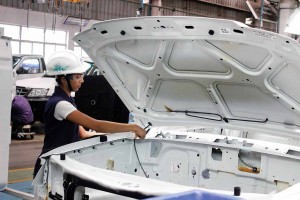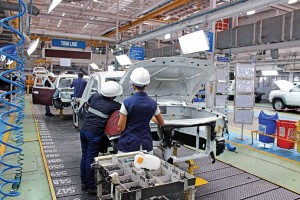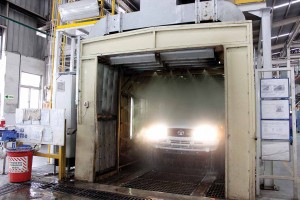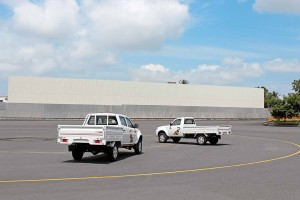Building on a long legacy of pick-up trucks starting with the Tatamobile, the Xenon Yodha looks contemporary and robust.
Story by:
Bhushan Mhapralkar
Photos:
Saurabh Botre
Tata Motors announced that they have signed action hero Akshay Kumar as the brand ambassador of its commercial vehicles in January 2017. His announcement was timed with the launch of the Xenon Yodha pick-up trucks. The advertisements that followed the announcement showed him driving the Tata Xenon Yodha pick-up under the Sun, the Moon, in the rain, and in precarious conditions. The last shot is particularly memorable as he pilots a Xenon Yodha across the sand dunes to deliver medicines to an army camp. It does not take long to understand that the advertisement is highlighting the ability of the Xenon Yodha to brave different weather conditions, often not very conducive, and not the most ideal, to accomplish the mission it has been tasked with. Tracing its history to the Tatamobile launched in the early 80s, the Xenon Yodha draws from the long-standing experience of the company to build pick-up trucks. It is in a segment that is typically described as the 3.5-tonne segment. Made up of pick-up trucks from homegrown players and from global players, the segment, according to Anurag Dubey, Head, Sales & Marketing, Small Commercial Vehicles Business Unit, Tata Motors Ltd., has been clocking 18,000 units per month. Over the next few years the segment is expected to gain momentum.
The looks
Commanding 23 per cent market share, the Xenon Yodha is available in a single cab and a double cab configuration. It could be had with a 4×2 and 4×4 driveline. A robust looking pick-up truck, differentiating the Xenon Yodha from the ‘conventional’ Xenon is the body coloured bumper. Structured across four key model configurations – 1.1-tonne (Yodha Eco), 1.25-tonne (Yodha PS), 1-tonne twin cab (Yodha DC 4×2) and 1.5-tonne (Yodha+) according to Vinay Pathak, Head – Product Line, SCVs, the possesses a distinctive cabin. Avers Pathak, “The distinct looking cabin of the pick-up truck is its calling card. It is a home for the driver away from home.” With the buyer often the operator, the cabin of the pick-up truck was designed to look aspirational. It thus looks stylish, and is modern and spacious inside. In the case of the load body, which is the business area, stress was laid to achieve a flat loading area. The load body is thus efficient and spacious. With attention to offer higher payload, the team in charge of the Yodha scavenged through the company bins to arrive at a pick-up truck that was far superior and way ahead of any pick-up available in the Indian market. Connoting three words – protective, practical and premium, according to Pathak, the Yodha points at the Tatamobile legacy through its design outline. Built to operate in hostile conditions, and be effective in business, the Yodha draws attention.
Capable of projecting the driver as a business executive and not just a commercial vehicle driver as he executes last mile deliveries, often of high value FMCG and consumer electronics, the team in charge of the Yodha factored in a high ground clearance of 210mm and high departure and approach angles. Complementing the ‘conventional’ Xenon range and the legacy 207 pick-up range, the Yodha was designed and engineered to make the driver (operator) feel at ease in an urban environment. Emphasis was laid on aggressive looks. Making the driver feel like a Yodha out to conquer business, the Yodha, according to Anurag has been conceived on the Xenon international pick-up foundation to suit the Indian market and customer requirements. Exported to markets like South Africa, Thailand and Australia, the pick-up range as a platform is the technology showcase for Tata Motors in Australia. In the Australian market, it is offered with an auto transmission. Aimed at diverse applications in India like fruits, vegetables, agri-produce, FMCG, white goods, poultry, milk, fisheries, pharma, cash, parcel, courier, ecommerce, cash van, and more, the Yodha, flaunts trendy ORVMs, bold grille, and stylish head lamps.
The hardware
The Yodha has the cab and the load body bolted to the chassis. Its hardware consists of a 85 PS, 3-litre common-rail turbo diesel engine mounted longitudinally on a tubular frame. The frame, according to Pathak, is strong and rigid. It is different from that of the 207 and from that of the ‘conventional’ Xenon. It is four-mm thick with belly reinforcement. Avers Pathak, “The load body too is strong.” The suspension of the Yodha has been tweaked, and consists of semi-elliptical springs all round. It is unlike the ‘conventional’ Xenon, which could be had with an independent double wishbone front suspension. The rear suspension of the Yodha PS comes with two-stage leaf springs. The front has an anti-roll bar. Employing strong axles, the Yodha is fitted with a G76 five-speed manual transmission and a larger dia. clutch. Mentions Pathak, “The thinking behind Yodha was to have a robust workhorse.” With a 4×4 single cab variant, a 4×4 crew cab variant, and the Yodha+ (soon to be launched), the pick-up truck rides on 217/75 R16 radials. A range of products actually with the choice of a 4×2 manual steering version, a 4×2 power steering version, a manual steering version without the load body, and a power steering version without the load body under the Yodha Eco product vertical, the pick-up truck is a common usage vehicle aimed at motivated and hard working individuals. Pointing at the dual cab Yodha DC 4×2, Pathak states, “The Yodha ranges between one-tonne and 1.5-tonne payload.”
Developed by taking into consideration the market requirements and the variation in the tax rules in each state, the Yodha, according to Pathak, offers the best payload in the segment. Citing an observation that pick-up trucks are moving down and SCVs are moving up, Pathak expresses, “We have engineered the Yodha DC 4×2 to accommodate a one-tonne load body. We are striving to reduce the kerb weight without sacrificing the robustness of the vehicle. We are doing this to increase the payload capacity. We have succeeded in reducing the kerb weight of Yodha DC 4×2 by 7.5 per cent. The payload capacity has increased by 25 per cent.” Apart from the new tubular frame, weight saving was facilitated by the new axles (rigid front and live rear). The endeavour to save weight and offer higher payload will continue as new Yodha variants are launched. “We are introducing new variants in different markets to help clock additional volumes. We are seeing the Yodha fit into new application areas like isothermal and other special application vans,” says Anurag. To meet the market requirements, and that of the law, the team in charge of the Yodha worked on the load body height as well as the load body area. They also worked on minor details like side-drop load body and fixed side body. When launched, the Yodha+ will turn out to be the ‘Big Daddy’ of all Yodhas with a payload of 1.5-tonne. Currently, the Yodha PS is the largest selling.
Stating that overload is rampant, Pathak explains, “Customers are slowly coming to realise that it is better to run at rated load.” The strong traction enjoyed by the Yodha, mentions Pathak, stems from the fact that the operators are able to experience a product that is quite different than the Xenon. “We therefore look at it as the Yodha, and not as the Xenon Yodha,” he comments. Stressing upon an improvement in cabin space by 5.5 per cent from the re-arrangement of trim, the Yodha, according to Pathak, was built after listening to the customers. Attention was paid to make it comfortable to drive over longer distances. “We did a lot of customer clinics. We went back to the drawing board. We leveraged the best to engineer the Yodha to serve someone as conventional as a vegetable or fish transporter, and someone as special as the army,” he mentions. Providing a choice between the contemporary and the good old, the Yodha according to Pathak, is enjoying a smooth ride and a strong demand after migration to BSIV.”
The drive
What strikes foremost is the high floor height. Access seems a bit awkward at first. The gap between the seat and the flooring looks less. This inhibition is demolished as the driving position feels just right, or even a bit high-ish once behind the wheel. What seems like a flat seat, provides good support. The tilt adjustable steering is easily adjusted to arrive at a commanding driving position. The view ahead is good. The modern and straightforward dash, with the absence of a blower unit, does look a bit bare. The engine wakes up an amount of diesel clatter. Better insulation could do the trick perhaps. There are no vibes, and the clutch feels light. The gearbox feels smooth to operate. The taller first gear makes for an easy start. If the clutch travel feels a bit more than expected, the Yodha gathers speed fairly quickly. Out on the road, the commanding driving position makes for a good view ahead.
The steering wheel surprisingly offers good feedback. The Yodha PS feels quite car-like to drive. Despite the leaf springs all-round, the ride quality is decent. Over ideal surfaces it is pliant. Displaying good dynamics, the Yodha does not go past 80 kmph. As per the law, the top speed has been limited to 80 kmph, which is attained fairly quickly. The brakes, made up of discs at front and drums at the rear, exert a strong bite. They have a progressive feel about them, and aid the vehicle in shedding speed.
Compared to the Yodha PS, the Yodha DC feels more refined. It seems to be better at keeping the noise out. It also feels spacious with another row of seat behind. The driving position is as commanding, and the visibility as good. Like the Yodha PS, the rear view mirrors provide a good view. Light cutch and a smooth shifting five-speed manual gearbox makes for a car-like feel. Also, the ability to adjust the tilt of the steering column. The steering feedback is good and aids maneouvrability. If a sense of robustness is evident, the Yodha, in either form – dual cab or single cab, feels easy to drive and maneouvre. On the dual cab version, the rear suspension setup is slightly different. This has a bearing on the ride quality. The ride of the dual cab Yodha is pliant than the Yodha PS. True workhorses both, the Yodha DC and the Yodha PS, are. The anti-roll bar at front contributes; makes for predictable handing. Predictable handling makes it easy to negotiate the twists and turns. Strong brakes with a progressive feel inspire confidence.
The warrior clan
The modern, albeit aggressive appearance of the Yodha makes an impression. It is a smartly executed product with a robust hardware. Building on the legacy of the Tatamobile, the Yodha reflects on the experience of the company to provide commercial mobility solutions that result in lower cost of ownership. Designed and developed with diverse applications and buyer profiles in view, the Yodha presents the owner-operator with a pick-up truck that is smart and empowers him to do business in an urban environment, and across the vast countryside. Flaunting high ground clearance and a good approach and departure angle, the Yodha impresses with its car-like driving experience. It is not as plush, and could do with more noise insulation. Fit for accomplishing diverse tasks, the Yodha comes across as a fiery machine fit for the warrior clan.
Making the Yodha
The Yodha is built at the J18 block of the Tata Motors’ plant at Pune. The line is common to the Yodha, ‘conventional’ Xenon and the 207. The export Xenons are also made at the facility, and it is thus interesting to see jobs with a diferent, hydroformed frame roll down the final assembly. They flaunt different drivelines, suspension, and other parts. The overall manufacturing arrangement in the hall, as part of a huge integrated manufacturing complex, looks a bit unconventional. The hall itself is roughly broken into two compartments. The rear half, dedicated to the construction of the cabin BIW. Cabins for the 207, ‘conventional Xenon, and the Yodha share the same line. Kuka robots find application to carry out precise welds in hard to reach areas. Except the skin panels, all the other panels, including those of the door and the bonnet, are supplied by the vendors. Sub-assembly stations weld the door panels and the bonnet panels. They are then fitted to the cab.
The cab BIW is transferred to the paint shop adjoining the hall. From the paint shop, the painted cab BIW is delivered to a trim line on one side of the first compartment of the hall. Trim parts like glass, wiring harness, seats, etc., are fitted here. On the other side is the compartment is the final assembly line. Suspension, steering gear, driveline, cabin and load body marriage takes place over here, and as per the model configuration. At the plant level, there are said to be a whopping 350 configurations, including the complete pick-up family Tata Motors sells in India as well as in the international markets.



